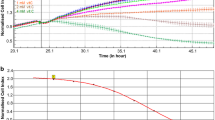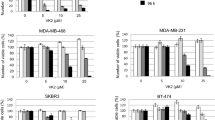Abstract
Purpose
Doxorubicin is an anthracycline drug which inhibits the growth of breast cancer cell lines. However, a major factor limiting its use is a cumulative, dose-dependent cardiotoxicity, resulting in a permanent loss of cardiomyocytes. Vitamin C was found to potentiate the cytotoxic effects of a variety of chemotherapeutic drugs including doxorubicin. The aim of the study was to describe the changes in protein expression and proliferation of the MCF-7 cells induced by the vitamin C applied with doxorubicin.
Methods
Label-free quantitative proteomics and real-time cell analysis methods were used to search for proteome and cell proliferation changes. These changes were induced by the pure DOX and by DOX combined with vitamin C applied on the MCF-7 cell line.
Results
From the real-time cell analysis experiments, it is clear that the highest anti-proliferative effect occurs with the addition of 200 µM of vitamin C to 1 µM of doxorubicin. By applying both the label-free protein quantification method and total ion current assay, we found statistically significant changes (p ≤ 0.05) of 26 proteins induced by the addition of vitamin C to doxorubicin on the MCF-7 cell line. These differentially expressed proteins are involved in processes such as structural molecule activity, transcription and translation, immune system process and antioxidant, cellular signalling and transport.
Conclusion
The detected proteins may be capable of predicting response to DOX therapy. This is a key tool in the treatment of breast cancer, and the combination with vit C seems to be of particular interest due to the fact that it can potentiate anti-proliferative effect of DOX.




Similar content being viewed by others
References
Abdel-Latif MM, Raouf AA, Sabra K, Kelleher D, Reynolds JV (2005) Vitamin C enhances chemosensitization of esophageal cancer cells in vitro. J Chemother 17:539–549
Arcamone F, Cassinelli G, Fantini G, Grein A, Orezzi P, Pol C, Spalla C (1969) Adriamycin, 14-hydroxydaunomycin: a new antitumor antibiotic from S. peucetius var. caesius. Biotechnol Bioeng 11:1101–1110
Beck R, Verrax J, Gonze T, Zappone M, Pedrosa RC, Taper H, Feron O, Calderon PB (2009) Hsp90 cleavage by an oxidative stress leads to its client proteins degradation and cancer cell death. Biochem Pharmacol 77:375–383
Burger K, Mühl B, Harasim T, Rohrmoser M, Malamoussi A, Orban M, Kellner M, Gruber-Eber A, Kremmer E, Hölzel M, Eick D (2010) Chemotherapeutic drugs inhibit ribosome biogenesis at various levels. J Biol Chem 285:12416–12425
Cameron E, Campbell A (1974) The orthomolecular treatment of cancer. II. Clinical trial of high-dose ascorbic acid supplements in advanced human cancer. Chem Biol Interact 9:285–315
Chen Q, Espey MG, Sun AY, Pooput C, Kirk KL, Krishna MC, Khosh DB, Drisko J, Levine M (2008) Pharmacologic doses of ascorbate act as a prooxidant and decrease growth of aggressive tumor xenografts in mice. Proc Natl Acad Sci USA 105:11105–11109
Ciftci K, Su J, Trovitch PB (2003) Growth factors and chemotherapeutic modulation of breast cancer cells. J Pharm Pharmacol 55:1135–1141
Cortés-Funes H, Coronado C (2007) Role of anthracyclines in the era of targeted therapy. Cardiovasc Toxicol 7:56–60
Cummings J, Anderson L, Willmott N, Smyth JF (1991) The molecular pharmacology of doxorubicin in vivo. Eur J Cancer 27:532–535
Doroshow JH (1986) Prevention of doxorubicin-induced killing of MCF-7 human breast cancer cells by oxygen radical scavengers and iron chelating agents. Biochem Biophys Res Commun 135:330–335
Evans AR, Miriyala S, St Clair DK, Butterfield DA, Robinson RA (2012) Global effects of adriamycin treatment on mouse splenic protein levels. J Proteome Res 11:1054–1064
Fornari FA Jr, Jarvis WD, Grant S, Orr MS, Randolph JK, White FK, Mumaw VR, Lovings ET, Freeman RH, Gewirtz DA (1994a) Induction of differentiation and growth arrest associated with nascent (non-oligosomal) DNA fragmentation and reduced c-myc expression in MCF-7 human breast tumor cells after continuous exposure to a sublethal concentration of doxorubicin. Cell Growth Differ 5:723–733
Fornari FA, Randolph JK, Yalowich JC, Ritke MK, Gewirtz DA (1994b) Interference with DNA unwinding by doxorubicin in MCF-7 breast tumor cells. Mol Pharmacol 45:649–656
Goldenberg GJ, Wang H, Blair GW (1986) Resistance to adriamycin: relationship of cytotoxicity to drug uptake and DNA single- and double-strand breakage in cloned cell lines of adriamycin-sensitive and -resistant P388 leukemia. Cancer Res 46:2978–2983
Gooch JL, Yee D (1999) Strain-specific differences in formation of apoptotic DNA ladders in MCF-7 breast cancer cells. Cancer Lett 144:31–37
Grote P, Schaeuble K, Ferrando-May E (2007) Commuting (to) suicide: an update on nucleocytoplasmic transport in apoptosis. Arch Biochem Biophys 462:156–161
Hahm E, Jin DH, Kang JS, Kim YI, Hong SW, Lee SK, Kim HN, da Jung J, Kim JE, Shin DH, Hwang YI, Kim YS, Hur DY, Yang Y, Cho D, Lee MS, Lee WJ (2007) The molecular mechanisms of vitamin C on cell cycle regulation in murine melanoma. J Cell Biochem 102:1002–1010
Hoffer LJ, Levine M, Assouline S, Melnychuk D, Padayatty SJ, Rosadiuk K, Rousseau C, Robitaille L, Miller WH Jr (2008) Phase I clinical trial of ascorbic acid in advanced malignancy. Ann Oncol 19:1969–1974
Kassouf W, Highshaw R, Nelkin GM, Dinney CP, Kamat AM (2006) Vitamins C and K3 sensitize human urothelial tumors to gemcitabine. J Urol 176:1642–1647
Kim H, Bae S, Yu Y, Kim Y, Kim HR, Hwang YI, Kang JS, Lee WJ (2012) The analysis of vitamin C concentration in organs of gulo mice upon vitamin C withdrawal. Immune Netw 12:18–26
Koch GJ, Biaglow JE (1978) Toxicity, radiation sensitivity modification and biological effects of dehydroascorbate and ascorbate in mammalian cells. J Cell Physiol 94:299–306
Kumaraguruparan R, Subapriya R, Kabalimoorthy J, Nagini S (2002a) Antioxidant profile in the circulation of patients with fibroadenoma and adenocarcinoma of the breast. Clin Biochem 35:27527–27529
Kumaraguruparan R, Subapriya R, Viswanathan P, Nagini S (2002b) Tissue lipid peroxidation and antioxidant status in patients with adenocarcinoma of the breast. Clin Chim Acta 325:165–170
Kuppusamy P, Li H, Ilangovan G, Cardounel AJ, Zweier JL, Yamada K, Krishna MC, Mitchell JB (2002) Noninvasive imaging of tumor redox status and its modification by tissue glutathione levels. Cancer Res 62:307–312
Lefrak EA, Pitha J, Rosenheim S, Gottlieb JA (1973) A clinicopathologic analysis of adriamycin cardiotoxicity. Cancer 32:302–314
Lin SY, Lai WW, Chou CC, Kuo HM, Li TM, Chung JG, Yang JH (2006) Sodium ascorbate inhibits growth via the induction of cell cycle arrest and apoptosis in human malignant melanoma cells. Melanoma Res 16:509–519
Ohtsuboa T, Kanob E, Uedac K, Matsumotob H, Saitoa T, Hayashib S, Hatashitab M, Jinb Z, Saitoa H (2000) Enhancement of heat-induced heat shock protein (hsp) 72 accumulation by doxorubicin (Dox) in vitro. Cancer Lett 159:49–55
Old WM, Meyer-Arendt K, Aveline-Wolf L, Pierce KG, Mendoza A, Sevinsky JR, Resing KA, Ahn NG (2005) Comparison of label-free methods for quantifying human proteins by shotgun proteomics. Mol Cell Proteomics 4:1487–1502
Prasad SB, Giri A, Arjun J (1992) Use of subtherapeutical dose of cisplatin and vitamin C against murine Dalton’s lymphoma. Pol J Pharmacol Pharm 44:383–391
Rebbaa A, Zheng X, Chu F, Mirkin BL (2006) The role of histone acetylation versus DNA damage in drug-induced senescence and apoptosis. Cell Death Differ 13:1960–1967
Roshchupkina GI, Bobko AA, Bratasz A, Reznikov VA, Kuppusamy P, Khramtsov VV (2008) In vivo EPR measurement of glutathione in tumor-bearing mice using improved disulfide biradical probe. Free Radic Biol Med 45:312–320
Rubens RD (1991) Single-agent chemotherapy. In: Powles TJ (ed) Medical management of breast cancer. Martin Dunitz, London, pp 131–137
Siegfried JA, Kennedy KA, Sartorelli AC, Tritton TR (1983) The role of membranes in the mechanism of action of the antineoplastic agent adriamycin. Spin-labeling studies with chronically hypoxic and drug-resistant tumor cells. J Biol Chem 258:339–343
Singal PK, Iliskovic N (1998) Doxorubicin-induced cardiomy-opathy. N Engl J Med 339:900–905
Taper HS, de Gerlache J, Lans M, Roberfroid M (1987) Non-toxic potentiation of cancer chemotherapy by combined C and K3 vitamin pre-treatment. Int J Cancer 40:575–579
Toma S, Maselli G, Dastoli G, De Francisci E, Raffo P (1997) Synergistic effect between doxorubicin and a low dose of all-trans-retinoic acid in MCF-7 breast cancer cell line. Cancer Lett 116:103–110
Vargas-Roig LM, Gago FE, Tello O, Aznar JC, Ciocca DR (1998) Heat shock protein expression and drug resistance in breast cancer patients treated with induction chemotherapy. Int J Cancer 79:468–475
Verrax J, Stockis J, Tison A, Taper HS, Calderon PB (2006) Oxidative stress by ascorbate/menadione association kills K562 human chronic myelogenous leukaemia cells and inhibits its tumour growth in nude mice. Biochem Pharmacol 72:671–680
Verrax J, Vanbever S, Stockis J, Taper H, Calderon PB (2007) Role of glycolysis inhibition and poly(ADP-ribose) polymerase activation in necrotic-like cell death caused by ascorbate/menadione-induced oxidative stress in human chronic myelogenous leukemic cells. Int J Cancer 120:1192–1197
Weiss RB (1992) The anthracyclines: will we ever find a better doxorubicin? Semin Oncol 19:670–686
Yang YX, Sun XF, Cheng AL, Zhang GY, Yi H, Sun Y, Hu HD, Hu P, Ye F, Chen ZC, Xiao ZQ (2009) Increased expression of HSP27 linked to vincristine resistance in human gastric cancer cell line. J Cancer Res Clin Oncol 135:181–189
Yue J, Lu H, Liu J, Berwick M, Shen Z (2012) Filamin-A as a marker and target for DNA damage based cancer therapy. DNA Repair 11:192–200
Zaizen Y, Nakagawara A, Ikeda K (1986) Patterns of destruction of mouse neuroblastoma cells by extracellular hydrogen peroxide formed by 6-hydroxydopamine and ascorbate. J Cancer Res Clin Oncol 111:93–97
Zhang B, Zhang Y, Dagher MC, Shacter E (2005) Rho GDP dissociation inhibitor protects cancer cells against drug-induced apoptosis. Cancer Res 65:6054–6062
Zoli W, Ricotti L, Barzanti F, Dal Susino M, Frassineti GL, Milandri C, Casadei Giunchi D, Amadori D (1999) Schedule-dependent interaction of doxorubicin, paclitaxel and gemcitabine in human breast cancer cell lines. Int J Cancer 80:413–416
Funding
This study was supported by the Agency of the Slovak Ministry of Education for the Structural Funds of the EU, under project ITMS: 26220220143.
Author information
Authors and Affiliations
Corresponding authors
Ethics declarations
Conflict of interest
All authors declare no conflict of interest.
Ethical approval
This article does not contain any studies with human participants or animals performed by any of the authors.
Informed consent
Informed consent was obtained from all individual participants included in the study.
Rights and permissions
About this article
Cite this article
Bober, P., Alexovic, M., Talian, I. et al. Proteomic analysis of the vitamin C effect on the doxorubicin cytotoxicity in the MCF-7 breast cancer cell line. J Cancer Res Clin Oncol 143, 35–42 (2017). https://doi.org/10.1007/s00432-016-2259-4
Received:
Accepted:
Published:
Issue Date:
DOI: https://doi.org/10.1007/s00432-016-2259-4




